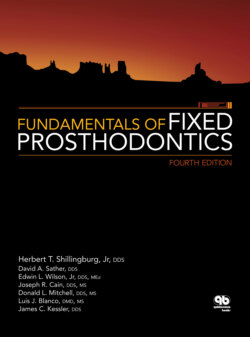Читать книгу Fundamentals of Fixed Prosthodontics - James C. Kessler - Страница 106
Removable partial denture
ОглавлениеA removable partial denture is generally indicated for edentulous spaces greater than two posterior teeth, anterior spaces greater than four incisors, or spaces that include a canine and two other contiguous teeth (ie, central incisor, lateral incisor, and canine; lateral incisor, canine, and first premolar; or the canine and both premolars).
An edentulous space with no distal abutment will usually require a removable partial denture. There are exceptions in which a cantilever fixed partial denture can be used, but this solution should be approached cautiously. See the section on cantilevers later in the chapter for a more detailed description of this type of restoration. Multiple edentulous spaces, each of which may be restorable with a fixed partial denture, nonetheless may call for the use of a removable partial denture because of the expense and technical complexity. Bilateral edentulous spaces with more than two teeth missing on one side also may call for the use of a removable prosthesis instead of two fixed prostheses.
Fig 7-1 Tooth position and alignment are maintained in part by the interaction between teeth (arrows).
Fig 7-2 When a tooth is removed or lost, adjacent teeth often migrate into the vacated space.
Fig 7-3 If a fixed partial denture is fabricated without first reestablishing the occlusal plane, an occlusal interference may be created (arrow).
Fig 7-4 Occlusion is properly restored by correction of the occlusal plane in conjunction with placement of a fixed partial denture.
The requirements of an abutment for a removable partial denture are not as stringent as those for a fixed partial denture abutment. Tipped teeth adjoining edentulous spaces and prospective abutments with divergent alignments may lend themselves more readily to use as removable rather than fixed partial denture abutments. Periodontally weakened primary abutments may serve better in retaining a well-designed removable partial denture than in bearing the load of a fixed partial denture. It is also possible to design the partial denture framework so that retentive clasps will be placed on teeth other than those adjacent to the edentulous space.
Short teeth or those with short clinical crowns usually are not good fixed partial denture abutments for anything other than a single pontic prosthesis. An insufficient number of abutments may also be a reason for selecting a removable rather than a fixed partial denture.
If there has been a severe loss of tissue in the edentulous ridge, a removable partial denture can more easily be used to restore the space both functionally and esthetically. For successful removable partial denture treatment, the patient should demonstrate acceptable oral hygiene and show signs of being a reliable recall candidate.
Table 7-1 Types of prostheses used for the replacement of missing teeth
Patients of advanced age who are on fixed incomes or have systemic health problems may require special treatment simplification efforts, either to cut down on the amount of appointment time required to restore the mouth or to make the treatment affordable. Cajoling patients of limited means into overinvesting their resources is not in their best interest.
A large tongue is a good reason to avoid a removable prosthesis if at all possible, as is a lack of muscular coordination. An unfavorable attitude toward a removable partial denture also makes it a poor choice.
